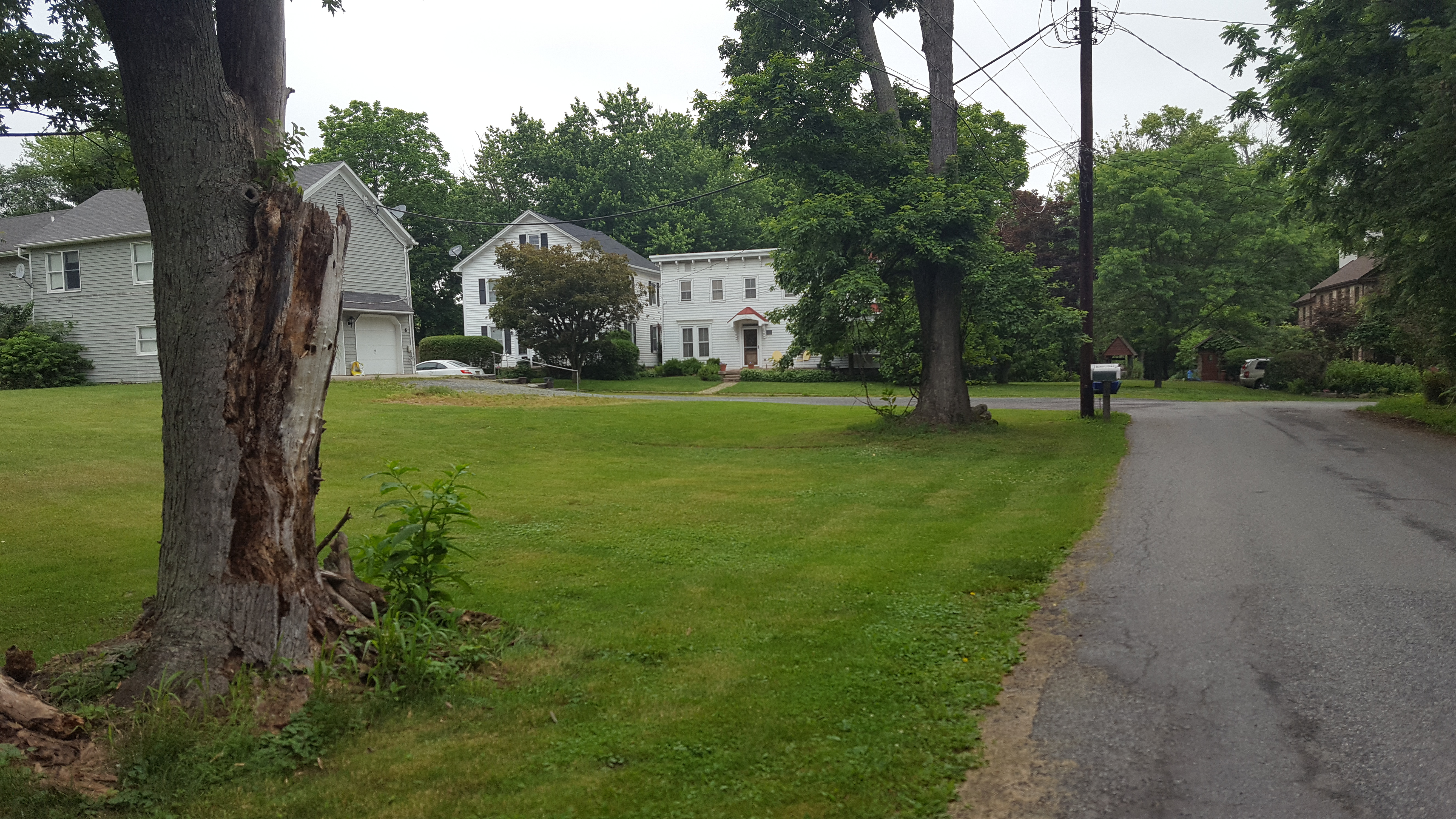Imlaydale is located in the Highlands geographical province of northwestern New Jersey, in the broad, rolling Musconetcong River valley of southern Warren County. The small hamlet hugs the north bank of the Musconetcong River just upstream from where Route 31,passing through a saddle in the long ridge defining the southern side of the valley, crosses the river. A water power site utilized by 1800, and perhaps earlier, provided the nucleus for the settlement, which consists of several houses clustered around a grist mill along a road terminating at an abandoned bridge crossing. Another house, a parsonage standing a short distance to the southwest is now separated from the other buildings by Route 31. The community is surrounded by a mix of open fields and woodland with scattered modern dwellings and older farmsteads; a number of businesses are found to the north and south along Route 31. To the south of Imlaydale off Route 31 is the small town of Hampton; the village of New Hampton is located a short distance upstream on the opposite side of the river.
The district contains eight principal buildings with attendant outbuildings. In large part they are vernacular, frame structures of moderate size, that date to the middle decades of the 19th century and exhibit simple stylistic embellishment typical of that era. Most have been enlarged or refurbished over the years. The buildings mostly are in good condition and well maintained. Yards generally are landscaped and well kept.
Imlaydale's architecture is representative of the region's vernacular construction practices and building types and reveals the influence of several architectural styles that were popular in the 19th century. The district's two earliest dwellings exemplify the traditional, 2-story, gable-roofed house types with single-pile plans, regularly fenestrated facades, and interior gable-end chimneys that are ubiquitous in the Delaware Valley's 18th and 19th century housing stock. The Stewart-Cramer House, a coursed rubble-stone structure dating c.1832, has a single-pile, center-pile floor plan of Georgian derivation and simple late Federal style detailing. Its c.1830-50 neighbor is an unadorned frame dwelling with a two-room single-pile plan and a bank cellar. In contrast to them are three houses dating to the third quarter of the 19th century. With its blocky form and low-pitched roof with wide bracketed eaves, the Peter Cramer House evokes the Italianate cubical villa design. Gothic Revival influences are evident in the central front gable and scalloped barge boards of the Presbyterian Parsonage. Victorian penchant for asymmetry and exuberant ornament found expression in the southeast facade of house #6 which has a two-tiered bay window hugging one corner and elaborately detailed porch and bracketed cornice.
Outbuildings are found behind a few of the district's houses, most notable of which is the carriage house at the Peter Cramer House, a large frame building with pagoda-roofed cupola and boxed overhanging eaves. Much smaller and simpler are the small wagon house at the the parsonage and the stone smoke house with gable ventilation hole behind the Stewart-Cramer House. An auxiliary structure of another kind is the lime kiln (#10) in an isolated location on the river bank.
While Imlaydale's 19th-century store has not survived, its 1857 grist mill, despite modern alterations, remains a good example of the region's mill buildings and retains some of its works. The gable-end front of the braced-frame structure typically has a central entry on each story which is a cupola with hoist overhang.. Portions of the mill's hydro-system also have survived including a wide deep tail race and breached remains of the mill dam.
The district also contains two transportation-related resources. In the 19th century Imlaydale was linked to the outside world by the old road which crossed the river just north of the mill dam. While the wooden bridge there has been removed, its central stone pier remains intact. Imlaydale was bypassed to the west by the construction of a new bridge in 1913. This poured concrete structure is distinguished by two elongated segmentally arched vaults.
The District
We started by taking a look at the Valley Presbyterian Church Parsonage. This is actually on the other side of Rt 31 from the rest of the district. It's a nice looking building, easily viewed from the car. It's possible to park on this side and cross Rt 31, but Rt 31 is busy at times and crossing would be dangerous. We drove across and parked at the end of Imlaydale Rd closest to Rt 31.
Valley Presbyterian Church Parsonage - Frame, 2-story, gable-roofed dwelling consisting of a 3-bay single-pile main block with a cross gable centered on the front and gable-end chimneys (brick stacks) and a 2-story rear ell.
Style: Gothic Revival/Italianate
Date: c.1860-65 influences
Exterior features include clapboard siding, overhanging, eaves with scalloped, perforated barge boards, 2/2 and double 1/1 sash windows with plain trim, floor-length windows on the first story front, a central entry with transom, double doors, and simple flanking pilasters, and a flat-roofed front porch featuring a box cornice with wide frieze, square posts with cap, base and shoulder moldings, a pendant centered beneath the frieze in each bay creating an arcaded effect.
Outbuildings: frame, 2-story wagon house (later 19th century) with overhanging eaves, clapboard siding, and batten-doored side-wall entries.
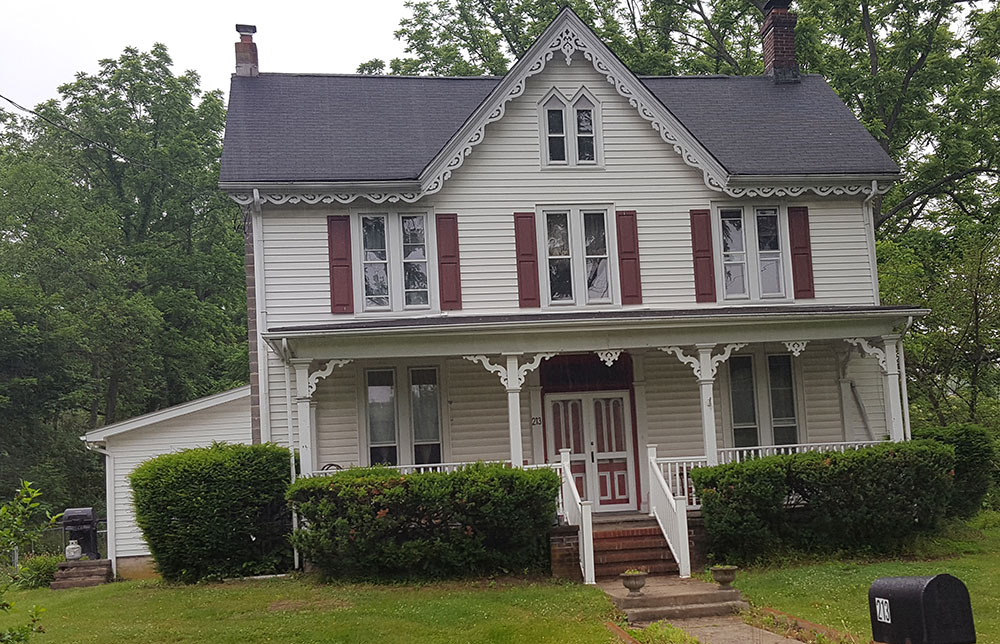
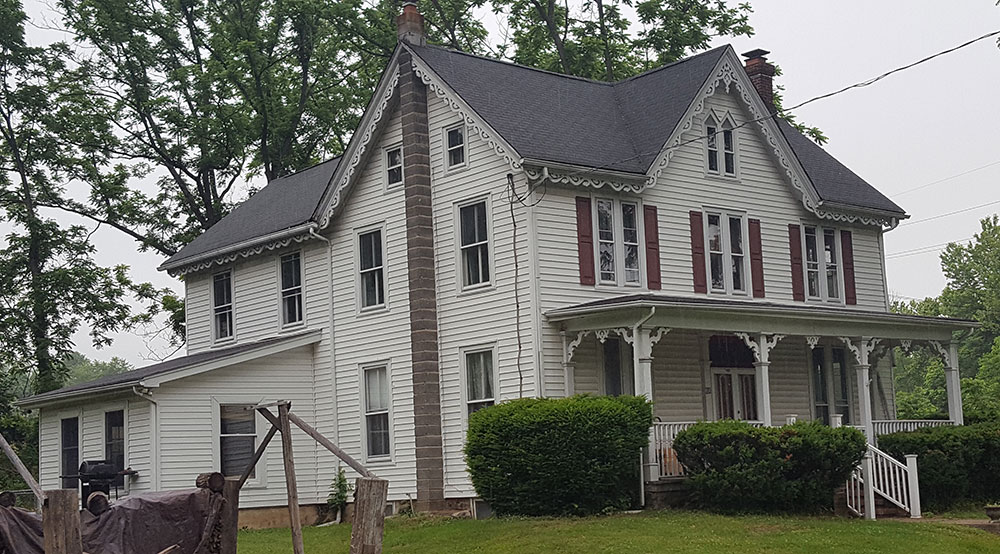
To view the bridge, we walked south along the shoulder of Rt 31 to its bridge over the Musconetcong River. During the summer, the bridge is visible, but obscured by vegetation. During a river cleanup, we had been able to walk across the bridge by approaching it from the south side. It's still very solid, but definitely starting to crumble.
Reinforced, poured-concrete bridge consisting of two elongated, segmentally arched vaults and with an open balustrade of square concrete posts and iron pipe rails.
Date: 1913
This bridge is visible from the Rt. 31 bridge. The road that leads to it from the north, from Imlaydale Road, is overgrown and blocked by a No Trespassing sign. The bridge is accessible from the south...


After taking a peak at the bridge, we walked Imlaydale Road a short distance. On the left, you'll see what looks like a large garage. This is actually the surviving part of an even larger barn that burned down. This garage is not considered historic. The two houses behind it, though, are. The one on the left is called House #5.
House #5. Frame, 2-story, duplex dwelling with a 2 over 4-bay gable end principal facade and a 1-story rear addition.
Style: none
Date: c.1860-74
It has clapboard siding, boxed overhanging eaves, 6/6 sash windows with eared and raked cornices, and paired inner-bay entries with modern glass and panel doors.
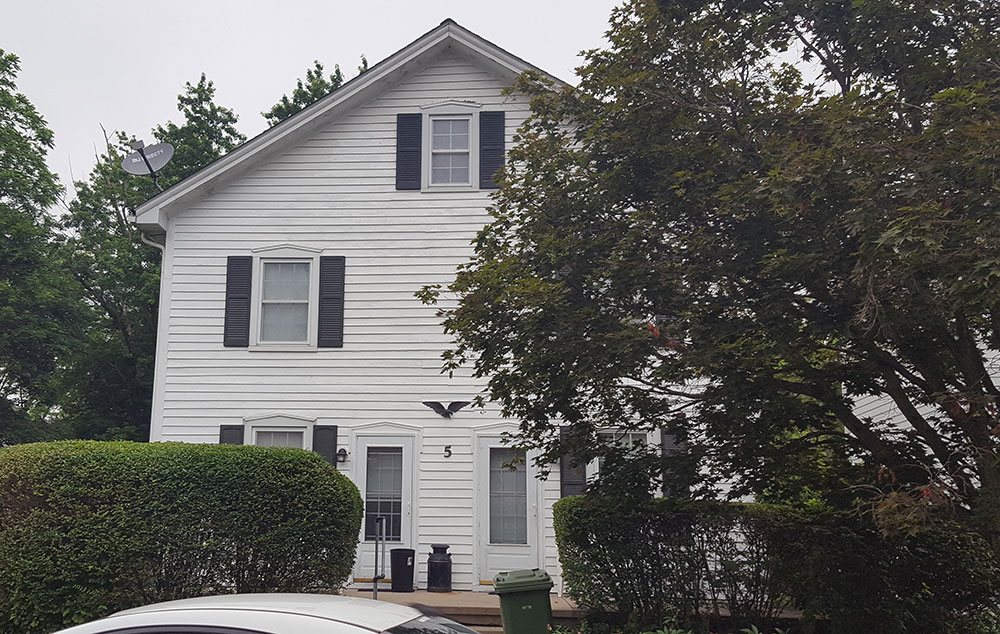
To the right of House #5, we see House #6. House #6 is a bit more ornate and looks more historic.
House #6. Frame, 2-story, flat-roofed, L-shaped dwelling with asymmetrically fenestrated, 5 over 3-bay southwest facade; an irregularly fenestrated southeast facade, a 2-story, false-fronted, shed-roofed, 1-bay appendage on the northeast side, and a small, 1-story appendage which partially squares out the north corner.
Style: Italianate influences
Date: c.1860-74
At the south end of the southeast facade is a two-tiered, rectangular bay window with pagoda roof, concave pent roof between the stepped tiers, bracketed cornices, banded narrow 1/1 sash windows, and an elaborately paneled spandrel beneath the lower window band. Other exterior features include clapboard siding, a bracketed built-up box cornice., mostly 2/2 sash windows, entries with glass and panel doors, and a flat-roofed porch on the southeast facade with turned posts, and jig-saw cut, perforated balustrade and cornice frieze. The masonry "terrace" on the southwest facade either survives from or replaces an entry porch.
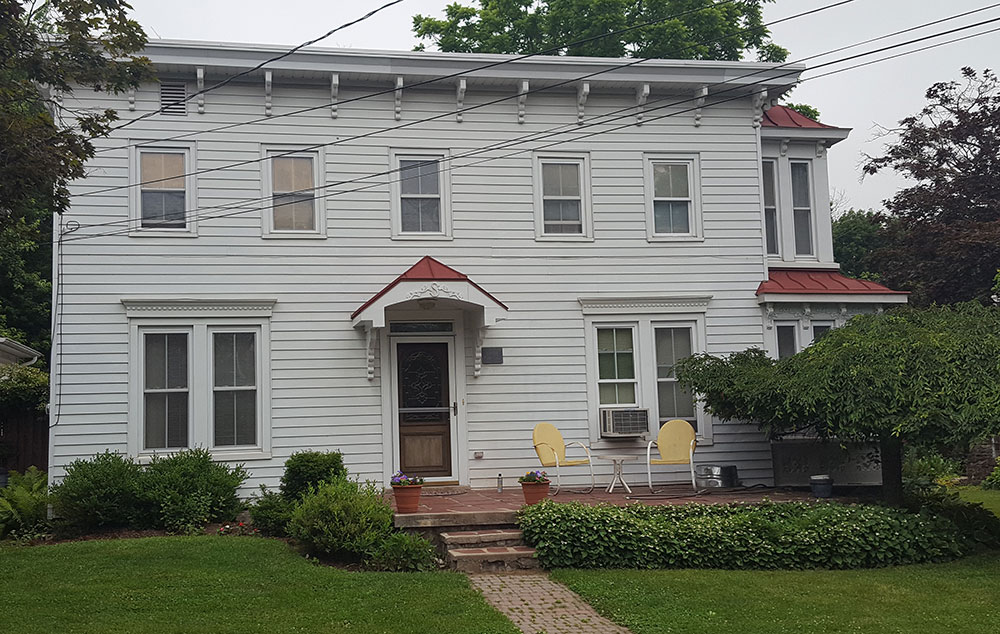
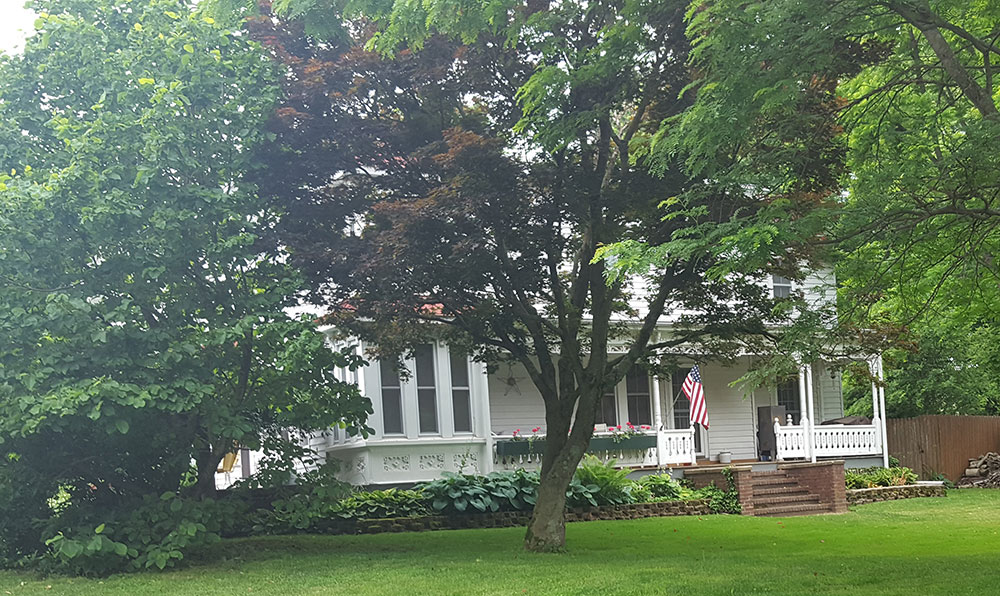
The Peter Cramer House is on the right side of Imlaydale Road, across from House #5 and House #6, but we weren't able to see it from the road. Perhaps we'll come back later in the year, when it's not as green.
Peter Cramer House - Frame, 2½ story, 5-bay, double-pile dwelling with low pitched hip roof, end-wall chimneys (brick stacks), and a 2½-story, hip-roofed rear wing.
Style: Italianate
Date: c.1950s
Although covered with aluminum siding, the exterior retains a bracketed box cornice, eyebrow windows between the cornice brackets, 6/6 sash windows, central entry with side-lights, transom, and one-panel door, a 1-bay entry porch with bracketed box cornice and octagonal porch, and a similar porch on the southeast side above which is a semi-hexagonal bay window. The sun porch with continuous band of 6/1 sash windows on the upper story of the originally 1-story rear wing was added in the early 20th century (in which work the wing's cornice brackets evidently were reused); the enclosed flat-roofed porch on the southeast side of the wing is a more recent alteration.
Outbuildings:
- Frame, 2½ story, gable-roofed carriage house (c. 1857-70) whose east corner is cutaway creating an L-shaped plan and asymmetrical rear gable. It has clapboard siding, boxed overhanging eaves, a louvered cupola with concave pyramidal hipped roof, mostly 4/4 sash windows, across gable on the short northeast wall, and northwest gable end entries with batten doors
- Small, frame shed (late 19th/early 20th centuries) with clapboard siding.
Turning the corner of Imlaydale Road, on the left, we see the Stewart-Cramer House (the mill is to our front at this point).
Stewart-Cramer House - Stone, 2-story, gable-roofed single-pile dwelling consisting of a 5-bay, center hall-plan main block with gable end chimneys (brick stacks), a slightly lower, 2-bay east wing with gable-end chimney (brick stack), and a frame, 1-story rear appendage, built in at least two sections.
Style: Federal influences
Date: c.1832
Among the early exterior features are box cornice with crown and bed moldings and returns, 6/6 and 9/6 sash windows with architrave trim, and a recessed main entry with architrave outer surround and 8-panel door whose recessed panels (featuring clip-cornered, slightly raised fields) match those lining the reveals. The rear porch with turned posts is a Victorian alteration as was the more elaborately detailed front porch removed not long ago. Stucco also has been removed from the walls and the stonework repointed.
Outbuildings;
- Stone, 1-story, gable-roofed smoke house (mid-19th century or earlier) with a batten-doored entry in the southwest gable end and a ventilation slit in the northeast gable
- Frame, 2-bay, gable-roofed privy (late 19th or early 20th century) with vertical siding and two batten doors and which leans markedly to the rear; and
- Bowlby family graveyard, a small plot located to the rear of the stone house just northeast of house 5 and house 6. Field stones are said to have been used to mark the early graves; no headstones survive (see below).
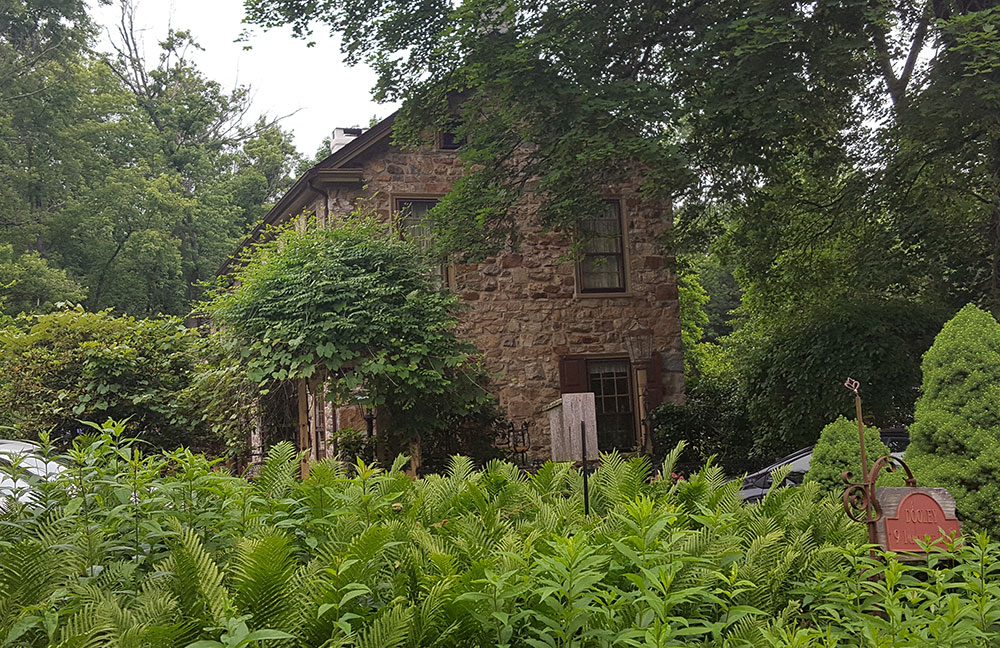
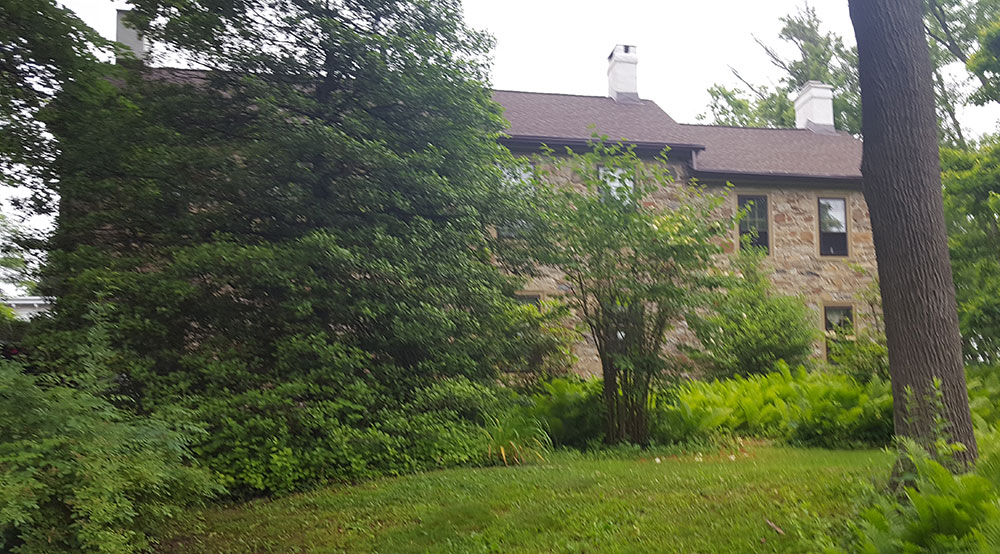
As we are looking at the Stewart-Cramer House to our right, the mill is in front. This is probably the most notable structure in the district. It's quite large and is in good shape - it looks like a mill! We were not able to see the breached dam that's on the river behind the house. We did get an inquiring look from the owner of the mill, but when we told her we were just exploring the historic district, she wished us a good day.
Imlaydale Mill - Frame, 2½ story, gable-roofed grist mill with a 3-bay northwest gable-end front, 4-bay side walls, and a basement story that is entirely above grade on the southeast gable end.
Date: 1857
Exterior features include clapboard siding, 6/6 and 1/1 sash windows with plain trim, and a cupola with hoist overhang centered on the ridge at the northwest gable end below which on each story is a center-bay entry (those on the second and third story retain batten doors).
The roof's low pitch results from alterations made in the 1950s when the side walls were raised several feet; around the same time a garage door was installed on the front wall to the right of the central entry. More recently, several windows have been replaced on the rear gable end.
Although the interior has been remodeled for residential and commercial use, the framing and much other early fabric remains as does a considerable amount of the mill works.
Related site features: The concrete-capped stone mill dam, breached at its midpoint, stretches across the river roughly in line with the east corner. While the tail race, a wide water-filled strait following the river bank for several hundred feet to the southwest, remains, the head race to the northeast has been largely filled in. The stone central bridge pier of the span which once crossed to the river a short distance upstream from the mill dam also survives.

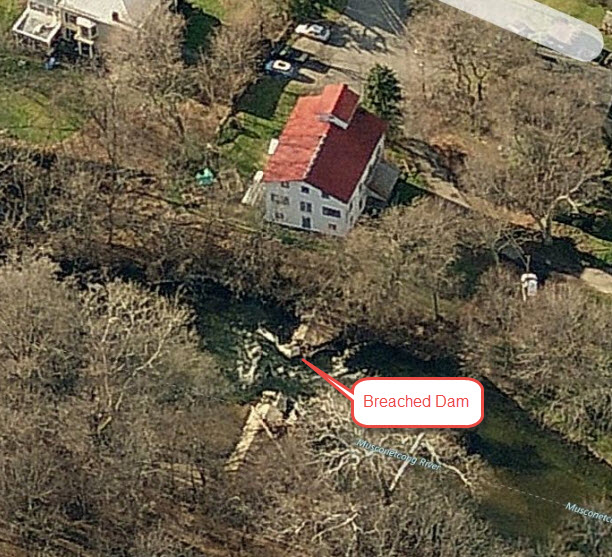
Continuing down the road behind and to the right of the mill, we come across our last stop (for now) - House #8. We ran into the owner of this house as well and had the opportunity to chat a little about the area.
House #8. Frame, 4 over 5-bay, 2-story, gable-roofed, single-pile dwelling with a bank cellar above grade at the south gable-end, a south gable-end chimney (brick stack), a small rear appendage, and a modern 1-story, north addition which incorporates a garage.
Style: none
Date: c.1830-50
It has flush eaves, clapboard siding, 6/6 sash windows with plain trim and modern decorative shutters, and a central entry with the modern glass and panel door and a small shed hood.
The headstones from the small family graveyard may have been incorporated in the poured cement foundation of the garage wing.
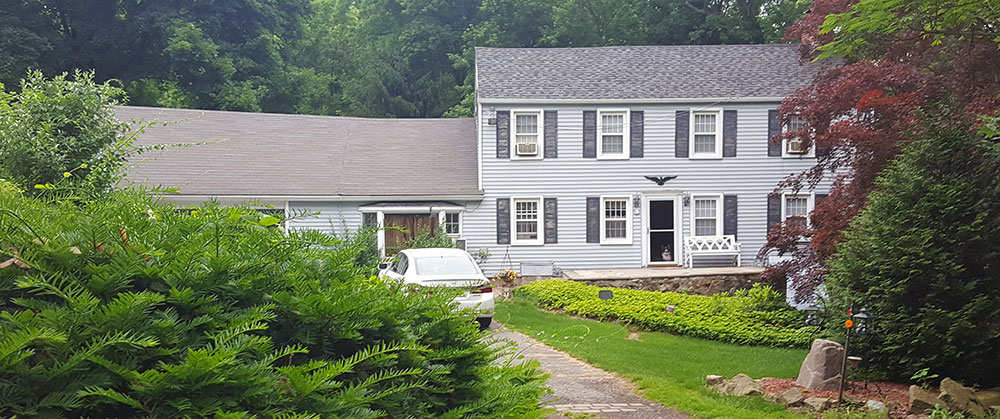
Somewhere further up the river is a lime kiln. The area was way too overgrown to try to find it that day, but we'll give it a shot in the fall or winter.
Stone, lime kiln built into sloping ground just above the river bank.
Style: none
Date: 19th century
Area History
Imlaydale possesses significance in the areas of community development, architecture, industry, politics/government and transportation. The hamlet exemplifies the smallest of the agglomerate settlements that proliferated throughout the region in the 18th and 19th centuries to serve its dispersed agricultural population, but whose growth was arrested when they were by-passed by 19th-century transportation improvements. The district has architectural significance as an assemblage of modest, mid-19th century buildings whose construction, form, detailing and spatial organization are illustrative of the rural region's vernacular architecture in that era. The industrial significance of Imlaydale stems from its grist mill whose history is representative of that of the small-scaled water-powered industry once characteristic of the region. Significance in the area of politics and government stems from late 19th-century owner of the mill complex, Peter Cramer, who was active in local Republican politics and held public office on both the state and local level. The district's significance for transportation lies in its 1913 reinforced concrete bridge, one of the earliest state-aid bridges in the area and one of the first in which the state had a direct role in design and construction.
The homestead site of one of the area's most prominent early settlers, Imlaydale was a settlement of some local importance with a grist mill established by 1792 and a store some years thereafter. In a period when the transportation of goods was largely limited to horse-drawn conveyances, such small communities provided the region's isolated rural population with almost its only centers for commercial and social activity. Although naturally favored by its location at a good water power site near the mouth of a mountain gap by which the middle portion of the Musconetcong Valley can be most easily entered from the south, Imlaydale was by-passed in the 19th century's turnpike, canal and railroad building booms. Overshadowed by neighboring communities with those advantages, Imlaydale has not grown since the middle decade of the 19th century.
As a result Imlaydale has managed to preserve much of its 19th-century character. Nearly all of the district's buildings date c. 1830-80. The distinctive historical character of the hamlet results from the survival of these buildings, their clustering around the focal point of the grist mill, and their juxtaposition with the surrounding open countryside. The district's buildings, mostly dwellings with attendant outbuildings, are in general well preserved and evidence relatively few modern alterations. Collectively they possess architectural significance. Their forms, construction, decorative embellishment, and siting provide a representative illustration of the rural region's vernacular architectural traditions and its assimilation of popular architectural styles. Of individual note are the c. 1832 Stewart-Cramer House, a coursed rubble-stone dwelling with single-pile, center-hall plan and Federal style detailing, the c. 1857-60 Peter Cramer House whose blocky form and low-pitched roof with wide bracketed eaves evoke Italianate cubical villas, and the Valley Church Parsonage, built 1860-65, which exhibits Gothic Revival influences in its central front gable and scalloped barge boards. The Imlaydale Mill, built in 1857 on the site of an earlier mill, remains, despite some modern alterations, a good example of the region's 19th-century mill buildings and retains elements of its mill works and hydro-system. The district's abandoned bridge, built in 1913 to carry the re-aligned Clinton/Washington Road over the Musconetcong River, also is of interest as an early area example of the use of reinforced concrete for bridge construction.
In addition, as a site occupied continuously since the 1730's and subject to limited development, Imlaydale may well have the potential to yield important archaeological information about the area's 18th and 19th-century material culture.
While Imlaydale developed as a mill hamlet in the 19th-century, its origins can be traced to the initial European settlement of the Musconetcong Valley in the second quarter of the 18th century. The region's pioneer agriculturalists, mostly of British, Dutch, and German stock, were typically tenants or squatters on property acquired by absentee owners through New Jersey's system of proprietorial landholding. Relatively few of the earliest settlers were freeholders, and perhaps even less commonly were West Jersey proprietors among the pioneers. The pioneer settler at Imlaydale, however, was English-born John Bowlby who by inherited proprietory right acquired title to several thousand acres in the Musconetcong Valley in the 1730s.
According to family genealogists, John Bowlby (c. 1700-82) came to America in 1726-27 in company with his father Thomas (1665-1731), a saddler of Mansfield Woodhouse, England, who was married to the daughter of Samuel Barker, a gentleman from nearby Barlborough whose landed interests included 4/5ths of a West Jersey proprietory. The American journey evidently was precipitated by an agreement made in April, 1726 by which the elder Bowlby gained control of most of his late father-in-law's New Jersey holdings from the other heirs. This inheritance, supplemented by his own purchase of a fractional properietory share, entitled Thomas Bowlby to thousands of acres of land in West Jersey, including parcels previously surveyed and allotted to Samuel Barker and rights to unallocated land. The Bowlbys settled in Burlington County, New Jersey where the elder Bowlby died in 1731. His will devised substantial lands in West Jersey to his children. John Bowlby was to receive "his full, quantity" of his father's land and was appointed co-executor with Abraham Heulings, Esq. The executors were directed to dispose of Thomas Bowlby's West Jersey lands "to the advantage of (his) children." Bowlby's sons Thomas and George also immigrated to New Jersey, as did a fourth son Richard who settled near his brother John in the Musconetcong Valley.
The West Jersey proprietorship devolved to John Bowlby as his father's executor, and recorded deeds testify to his extensive land dealings over the next several decades. Through references to his place of residence, deeds also suggest that he moved from Burlington to the Musconetcong valley in 1737. A 1765 resurvey indicates that the land on which he settled encompassed over 5,000 acres and stretched northward from the Musconetcong River across the fertile limestone valley and over Pohatcong Mountain into the next watershed. Besides rich agricultural soils, the tract contained a valuable mill site. According to tradition, presumably handed down in the family, which was recorded in 1869-70:
When John Bowlby was running the boundaries of his land, Col. Daniel Coxe was also laying out a tract to the east of him. There seems to have been some strife between them as to who should get his survey entered upon record first, and at the same time get as much of the creek as possible.
Coxe became alarmed, mounted his horse and rode towards Burlington as fast as he could, while Bowlby ran his lines so far as to take up the whole stream, keeping Coxe out of every foot of it. He then mounted a horse and followed Coxe, who rode one horse to death, borrowed another, and thus reached Burlington first. But Bowlby "kept him out of the creek" and that was all he desired, for he now had the mill site, and the most valuable portion of the land.
The same traditional account locates Bowlby's homestead at Imlaydale "near where Peter Cramer now lives." His hewn-log, 1½-story dwelling "was once considered the grandest house in the settlement" since it had "two large rooms below stairs, while the other houses had only one. It was the first house built (there)." The account is less informative about the first mill at Imlaydale, noting only that before it was built John Bowlby had to transport his grain over ten miles "through the wilderness" to Pittstown to be ground. While John Bowlby may have erected a grist mill at Imlaydale, no record has been found of any mill there before 1792.
As a large landowner, John Bowlby must have been a man of some position and influence in the community. This is perhaps reflected in the choice of the name of Mansfield Woodhouse, the English town from which the Bowlbys came, for the new Sussex County township created in 1754 from the central portion of the Musconetcong Valley. The name was also adopted by the neighborhood's pioneer church, a Presbyterian congregation formed as early as 1740, whose log meetinghouse was built on Bowlby land. John Bowlby and his wife Mary conveyed the church lot and graveyard to the congregation in 1765. Unlike his brother Richard who served as township representative to the county Board of Chosen Freeholders in 1765-69, there is no record of John Bowlby holding elected office; however, the names of the township's freeholders previous to 1765 and of other local officials before 1779 have not survived.
After the 1765 resurvey Bowlby evidently disposed of much of his Musconetcong Valley land. Several tracts were conveyed to his three sons who settled in the neighborhood; other parcels apparently were sold to local farmers. According to the 1869-70 account he "sold hundreds of acres of land for 2s, 6d. per acre because he did not wish to pay taxes on it." Local residents at that time recalled
hearing their grandfathers tell about the time when they could have bought land from Bowlby for 50cts. per acre. It must be remembered that in those days taxes were high in proportion to the value of the land; and while land was plentiful, money was scarce.
Despite his extensive landholdings, John Bowlby does not appear to have acquired any great wealth. In fact, the inventory of his "goods and chattels" made after his death in 1782 totaled about 60 pounds, certainly a substantial amount for the period in rural Sussex County, but hardly what one would expect for an individual who had once owned several thousand acres. Except for two cows, the inventory includes no mention of any items relating to the operation of a farm or mill, suggesting that upon retiring in old age he had disposed of his stock and tools.
John Bowlby's 1779 will, offered for probate in 1782, devised half-acre lots to twelve grandchildren at what later became the nearby village of New Hampton and the remainder of his real estate in thirds to his two surviving sons, Thomas and Samuel, and his two grandsons, John and James, sons of his son John who presumably predeceased him. Division of the property evidently occurred by 1785, and the homestead at Imlaydale formed part of the share allotted to Samuel.
Samuel Bowlby (c.1735-1822) apparently lived on the homestead over the course of his long life. His residence, perhaps his father's noted house, was described by a descendant as "a log dwelling with walls of a pinkish hue," probably a tinted wash commonly used in the area. He presumably was a farmer and, like his father, had considerable land dealings, selling portions of his property and in later life at least leasing much of the remainder. He also evidently built or rebuilt the grist mill at Imlaydale. A family geneaology makes reference to an 1801 quit claim deed (which apparently was not recorded) from Samuel Bowlby to Henry Dusenberry, a merchant and landowner at New Hampton, and to an agreement between the two "to build and operate a mill in partnership." That they were partners in the Imlaydale mill before 1792 is established by a road survey of that year which locates "said Dusenberrys and said Bowlby's mill" on the site of the present mill.
Like his brother Thomas and uncle Richard, Samuel Bowlby held local township office, serving as tax collector for one year in 1787. He also served as a private in the Revolutionary War. He and his wife, Elizabeth Dunn, had six children, most of whom married and settled in the neighborhood, although two sons may have moved to the west for a time. Like that of his father, Samuel's estate was surprisingly modest. The inventory made after his intestate death in 1822 totaled $550.08, most of which consisted of outstanding notes. By way of contrast, the estate of his partner in the mill, Henry Dusenberry, was valued at almost $9,000 in 1824.
At his death Samuel Bowlby's landholdings consisted of two Musconetcong Valley properties, a 175-acre farm near Washington and a 250-acre tract astride the Musconetcong River that encompassed the homestead. The division and sale of his real estate ordered by court-appointed commissioners was opposed by several of the heirs, and a state Prerogative Court case was instituted to settle the matter. Testimony presented to the court indicates that several of his children and grandchildren lived on the two properties at various times and that four of them were in residence in 1825. The commissioners' sale was blocked, except for the half interest in the mill and a 6-acre meadow lot. Both properties were offered for sale at an auction held June 27, 1827, at which time Dusenberry's half interest in the mill was also sold. Although no record of the division survives, shortly thereafter Bowlby's remaining lands appear to have been divided among his heirs.
High bidder for the two-acre mill lot was Dr. William Clark (1796-1857), a young physician recently settled at Belvidere, the seat of newly formed Warren County. Clark, who also acquired the "Point Mills" several miles upstream from Imlaydale, evidently supplemented his successful medical practice by investing in mill properties. He pad $1,453 for the Bowlby/Dusenberry mill and sold the property, enlarged by the addition of a small lot on the south side of the river, in 1832 to Thomas G. Stewart for $5,000. That he made improvements to the mill could explain the large price increase, Regardless of what if any work was done during his ownership, Clark must be credited with naming the community in honor of his mother who was born Margaret Imlay.
The first recorded use of the name Imlaydale for the settlement appears in Gordon's 1834 Gazeteer of the State of New Jersey wherein it is described as a "pleasant hamlet on the Musconetcong Creek....contain(ing) a mill, a store, and 3 dwellings. The store probably was a recent enterprise, established by either Clark or Stewart; later deed references place it or its successor on the mill lot to the west of the mill, somewhere between house #6 and the stone house. Stewart is said to have built a house upon his acquisition of the property. This probably was the stone house which stylistically can be dated to around that time. Unlike Clark, Thomas G. Stewart (c.1789-1859) probably lived at Imlaydale. In addition to the mill lot he purchased about 280 mostly contiguous acres there in the 1820's and 1830's by several conveyances, including a 38-acre tract to the north of the mill lot in 1831 from Mary Lacy, one of Samuel Bowlby's daughters, and a .25-acre "lot and premises" (the site of house 5 and house 6) adjoining the mill property on the west in 1835 from Alexander Bowlby. The .25-acre lot which earlier in 183-5 had been subdivided from a larger parcel owned by Sarah Hess, another daughter of Samuel Bowlby, probably was the location of one of the hamlet's other dwellings.
In 1840, Thomas Stewart and his wife sold about 80 acres of their Imlaydale property, including the mill.lot and adjoining parcels, to Isaac N. Carpenter who later that year sold the small house lot and the adjoining store to Samuel Garrison. Carpenter retained ownership of the remainder of the property until 1848 when he sold it to Noah Cramer who proceeded to enlarge his holdings by the purchase of an adjoining 31-acre parcel from the executors of Sarah Hess in 1850. Noah Cramer (1801-75) had engaged in milling at several locations before acquiring the Imlaydale mill and farm. He operated both enterprises until 1857, when he sold the mill and about 10 acres of land to his son Peter, and thereafter continued farming. The grist mill was rebuilt by Peter Cramer (1824-89) who successfully carried on the business for over thirty years. The Cramers completed their land holdings at Imlaydale by the purchase from former merchant Marcus Wells of the store property in 1866 and the adjoining house lot in 1872. Noah Cramer retained ownership of the 82-acre Imlaydale farm and the stone house until his death, after which it was sold to a local farmer, William Miller.
That the middle decades of the 19th century were a prosperous period for the Cramers and Imlaydale is attested to by the building which occurred then. Imlaydale's present mill was constructed in 1857 by Peter Cramer who built his substantial adjoining residence within the next few years, possibly by 1860 as the county map of that year depicts the house of "P. Cramer" on the site. The Valley Church parsonage was erected between 1860 and 1865 on land owned by Noah Cramer and later conveyed to the congregation. The Cramers were probably responsible for the construction of the two other houses erected in the hamlet in the 1860s or 1870s, the duplex which was occupied by a variety of tenants including mill hands, laborers, and perhaps an upholsterer and a milliner and the larger, more elaborately detailed dwelling next door which was inhabited by Peter Cramer's brother John and later his son Samuel both of whom were employed in the mill business. The large bank barn whose small ell was its only section to survive a recent fire, was either built by Noah Cramer or by William Miller after his acquisition of the Imlaydale farm in 1876. That this development pattern, which remains unchanged today, had occurred by 1873 is clear from the depiction of Imlaydale in the 1873 Hunterdon County atlas.
While the store appears to have been discontinued by the 1870s, the mill business thrived. The 1860 Industrial Census indicates that Peter Cramer's mill produced 880 pounds of wheat flour worth $6,720 and 750 tons of feed worth $22,500 with a labor force of three and a capital investment of $3,500. It was the second largest of Washington Township's five grist mills. Cramer's business grew considerably in the 1860s. In 1870 his merchant operation produced wheat, rye, and buckwheat flour, corn meal, and oat feed valued at $47,338 and his custom work amounted to flour and feed worth $9,562. The Imlaydale mill retained its position as the township's second largest mill, but exceeded its first-placed competitor in the volume and value of its custom work. In 1870 the water-powered mill, still operating with a labor force of three, utilized 30 horse power to run machinery which included four runs of stones, three bolts, six elevators, three screens, and one hulling stone. Cramer continued to make improvements to the mill; in the 1880s he installed "new process" machinery and made the mill, according to his obituary, "one of the best in his part of the state." Cramer dealt extensively in flour and feed and for many years held a seat in the New York Produce Exchange.
Peter Cramer had other business and political interests. He helped found two local banks and served on the Boards of Directors of both for many years. He also was active in Republican politics as one of the principal organizers of the local party in 1856-57, as a delegate to many party conventions, and as a state and local office holder. He served on Washington Township's Township Committee for many years and was elected to the state senate from Warren County in 1878.
Upon his death in 1889, the mill property at Imlaydale was inherited by his son Samuel who had much less success in the business which probably is explained partly by his own improvidence and partly by dislocations in the flouring business whereby small local producers could not compete with large operations using cheaper mid-western wheat. By the early 1900s, Samuel Cramer was bankrupt, and after his death his trustees conveyed the mill property together with the "large homestead dwelling" and other appurtenances to William W. Supplee in 1906. The Supplees operated the mill as a feed business for many years thereafter and it remained in the hands of the family until 1968.
It was early in the tenure of the Supplees at Imlaydale that the north/south road from Washington to Clinton was designated for improvement as one of the new "blue routes" adopted by the State Highway Commission. Improvements were made to the road section by section over the course of several years, and in 1913, the first year in which the State Road Department "had a voice in the design and construction of highway bridges," a new state-aid bridge was built just west of Imlaydale to carry the relocated road over the Musconetcong River. The reinforced concrete structure evidently was completed in the following year at a total cost of $9,989.81. Officials certifying its completion in accordance with plans and specifications were county engineers Grant Davis (Hunterdon County) and F.W. Salmon (Warren County) and state inspector James W. Bogart. The bridge remained in use until the 1930's when a concrete slab replacement bridge was built along side of it in conjunction with the construction of State Route 30 (present-day Route 31).
Imlaydale exists today as a largely residential community whose 19th century rural character and setting survive substantially intact. Since the late 19th-century, it has lost only one major structure, the large barn recently destroyed by fire whose surviving ell has been remodelled for residential/church use as has the grist mill for residential/commercial use. Despite increasing development pressure in the Route 31 corridor, much of the agricultural land surrounding the community remains open.
Helpful tips
This area is compact and has a very residential feel. I'm not sure where the public road is, but it definitely has the feel of walking up and down people's driveways. The two residents we ran into were friendly, though, once they knew we weren't there to case the joint. Again, please be respectful of private property.
Probably best to visit in late fall to early spring as the area has plenty of vegetation, making some things difficult to see.
Near Here
There are numerous restaurants and a few antique stores in Washington, along Rt 31 and Rt 57.
Related / Alternative Activities
- Bowerstown Historic District
- Pleasant Valley Historic District
- Port Colden Historic District
